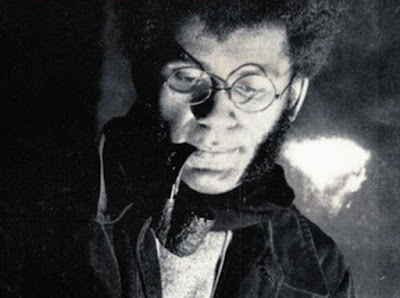Label:
Delmark Records – DS-428
Format:
Vinyl, LP, Album / Country: US / Released: 1974
Style:
Free Jazz, Avantgarde
Recorded At
Delmark Records, December 29, 1971.
Design
[Cover And Liner Design] – Turtel Onli
Producer
– Robert G. Koester
Recording
Supervisor [Supervision] – Anthony Braxton, Joseph Jarman
Note:
Track
titles and placements differ on the labels from the sleeve as follows.
A1
- Together Alone
............................................................................. 5:39
Composed By – Jos. Jarman
A2
- Down Dance 1-Morning (Including Circles) ............................... 16:04
Composed By – Jos. Jarman
B1
- CK-7-(GN) 436
............................................................................. 6:10
Composed By – Anthony Braxton
B2
- SBN-A12 66 K ............................................................................
14:53
Composed By – Anthony Braxton
Joseph
Jarman – soprano saxophone, synthesizer, flute, sopranino saxophone, alto
saxophone, bells, voice
Anthony
Braxton – contrabass clarinet, alto saxophone, piano, flute, voice
Joseph Jarman, c. 1970, Chicago by Tom Copi (Michael Ochs Archive/Getty Images)
Although
the purer thrust of issues originally addressed by that AACM as a communal
organization had changed through interaction with other musicians —Braxton, for
example, was in the midst of working in the landmark group Circle with Chick
Corea, Dave Holland, and Barry Altschul— Together Alone, as author Ronald M.
Radano suggests in his excellent book on Braxton New Musical Figurations
(University of Chicago Press, 1993), "looked back on performance
approaches first developed in the AACM. " Braxton and Joseph Jarman, both
with the Art Ensemble and on recordings of others (BYG's catalog is rempant
with semi-ad hoc configurations that both Braxton and Jarman had participated
in), had laid to rest the conscious insularity that made the AACM's deliberate
collectivism so effective at its peak, but this album proves they hadn't
surrendered the spirit that guided them in Chicago.
The
album opens with three Jarman compositions. The title track finds both Braxton
and Jarman on alto saxophone spinning long, languid, serene, and melancholy
unison lines; the path eventually forks and Braxton takes on a more rugged and
jagged trail while Jarman's remains smooth and flowing. Despite the musical
separation, the saxophones remain inextricably linked. One of the AACM
approaches Radano surely refers to on this recording is the integration of
silence and space. At times, the music goes against the grain of time, and
other moments it rejects it altogether. Leaving the music strewn with gaps of
silence rather than opting for a total sound density, the AACMers were among
the first in jazz to exploit space as a compositional tool.
The
opening track flows into "Dawn Dance." Braxton moving to piano and
Jarman picking up his flute. Oblique, spacious keyboard punctuations-including
some compelling inside-the-piano tinkling—provide a bed for Jarman's
outpourings which range from gentle, highly lyrical dreamweaving to almost
sharp, stuttered jags. The brief "Morning (Including Circles)" leaps
from a soothing peal of hand bells into dense cacophony. Amid myriad layers of
sound, the static bells become suddenly abrasive, Braxton and Jarman shouting
out of sync, while their shrill horns seem to simulate electronic white noise.
It's an exhilarating, early ascent into coarse textural exploration.
Braxton's
"Composition 21" ("CK7 [GN]") elaborates the textural
layering on a grander scale. Flutes, piano, contrabass clarinet, alto sax.
whistles, and abstract, sometimes jarring sounds on electronic tape provide an
extremely dense sonic collage, yet once one abides by the superficial level of
chaos, it becomes obvious that Braxton's sound sculpture is most certainly
ordered and well-conceived. Finally. Braxton's lengthy "Composition
20" ("SBN-A-1 66K") constructs a fine tension between lyrical
horn lines (his contrabass clarinet and Jarman's soprano saxophone) and an
almost static but changing ring of jingling bells. The bells develop in
complexity throughout the composition, providing an increasing tension with the
horns. Although the bells suggest no melody, their pattern becomes more and
more dense harmonically, while the attack of the horns doesn't fluctuate.
Aside
from being the only duet recording there is between these two masters. Together
Alone is far more than just a curious meeting. Elaborating on AACM concepts
with lessons learned in Paris, its exciting combination of one-on-one
collaboration with through-composed material sounds more vibrant and vital than
ever, over four decades since it was recorded.
_Review by Peter Margasek
If
you find it, buy this album!







JOSEPH JARMAN / ANTHONY BRAXTON – Together Alone (LP-1974)
ReplyDeleteVinyl Rip/FLAC+Artwork
Mediafire:
http://www.mediafire.com/download/cd94f69lhswb92q
whoa, amazing. thank you.
ReplyDeletefantastic!
ReplyDeleteBeautiful album Vitko, thanks!!
ReplyDeleteThank you,- this should be one to treasure,,,
ReplyDeleteThank you very much, Vitko!
ReplyDeleteenormous find, thank you so much!
ReplyDeletemany thanks...
ReplyDeleteThank you for this Delmark find. What a strange cover...
ReplyDeleteCheers, -Otto-.
DeleteRIP Joseph
ReplyDeleteYes, Jazz musician and composer Joseph Jarman has died. The New York chapter of the Association for the Advancement of Creative Musicians (AACM) has confirmed the news on their website, stating that the avant-garde luminary passed away on Wednesday, 9. January 2019. He was 81 years old.
ReplyDelete